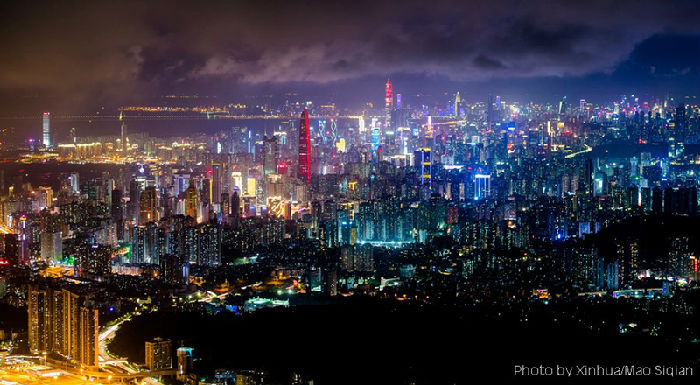



▲ Photo shows the night view of Shenzhen, south China's Guangdong Province. [Xinhua/Mao Siqian]
3. Optimize the layout and form of urbanization
Improve the integrated development of urban clusters and metropolitan circles, promote the coordinated development of the large, medium, and small cities and towns, and form a rational, collaborative, and functional layout of urbanization.
3.1 Promote the development of urban clusters by classification.
Enhance the population and economic capacity of urban clusters, establish and improve a multi-level coordination and promotion mechanism, and create a powerful driver and growth engine for high-quality development. Construct inter-city ecological and security barriers, build an urban system with a well-distributed layout and complete functions, and form polycentric, multi-level, and multi-node urban cluster networks. Strengthen the urban clusters with a strong capacity for driving the development of their surrounding special areas including impoverished areas, old revolutionary base areas, border areas, ecologically degraded areas, resource-based areas, old industrial cities, etc.
3.2 Foster several modern metropolitan circles.
Relying on megacities and big cities with a strong capacity for driving the development of their surrounding areas, to foster the central cities to integrate with surrounding cities, and take the one-hour commuting in urban areas as the basic range to foster and develop metropolitan circles. Formulate and implement the development plan for metropolitan circles and special plans for key areas, and establish a highly integrated promotion mechanism for surrounding cities with provincial coordination while led by the central city.
3.3 Improve the coordination development mechanism for urban clusters and metropolitan circles.
Explore the appropriate separation of economic management authority from the scope of administrative regions within urban clusters and metropolitan circles, and establish a mutually-beneficial and cost-sharing mechanism across the administrative regions. Take the lead in promoting the unified formulation and implementation of planning in the metropolitan circles, and explore the joint management of land and population.
3.4 Promote the transformation of the development of megacities.
Coordinate the economic, living, ecological, security, and other diversified needs to change the development and construction mode of megacities. Scientifically determine the urban scale and development intensity, and reasonably control the population density. Relive central urban areas of functions and facilities including general manufacturing, regional logistics bases, special markets, and over-concentrated public services such as medical care and higher education. Strengthen the prevention and control of risks in the governance of megacities, especially enhancing the energy security capabilities.
3.5 Improve the function and quality of large and medium-sized cities.
Give full play to the advantages of resources and industries, large and medium-sized cities undertake industrial transfer and functional relieving of megacities that conform to their functional position and development direction, promote the differentiated positioning of manufacturing industries, large-scale cluster development, build modern manufacturing industrial bases, trade and logistics centers, and regional professional service centers based on local conditions, consolidate the foundation for the development of the real economy. And support qualified central and western regions to foster and develop provincial sub-centers to guide the rational distribution of population and economy.
3.6 Enhance the development vitality of small cities.
Based on resource endowment and location advantage, promote small cities with mature factors, soils industrial foundation, and great development potential to speed up the development, foster and development characteristic and advantageous industries, continue to optimize the supply of public service, and enhance the ability of factor agglomeration, industrial undertaken, and population attraction. Support resource-exhausted cities to develop alternative industries according to their local conditions, ensure people’s livelihoods, and give help to the basic needs of people facing various difficulties.
3.7 Promote urbanization with a focus on county towns.
In tandem with the trend of population flow in county towns, select a number of qualified county towns to focus on development, make up for shortcomings and weaknesses according to local conditions and enhance the comprehensive carrying capacity. Improve the quality and efficiency of industrial supporting facilities in county towns in terms of industrial platforms, trade circulation and consumption platforms. Promote the functional cohesion and complementarity of counties and villages, encourage the extension of infrastructure and public service from counties to villages, and enhance the capacity for driving county towns to villages. And build 120 construction demonstration areas of county towns with high quality.
3.8 Guide the development of small towns by classification.
Adhere to developing small towns with proper scale, unique characteristics, and reasonable function based on local conditions. Support small towns around big cities to fully dovetail with urban needs, strengthen overall planning, functional convergence, and facilities supporting to develop into satellite towns. Promote the new urbanization of large-scale relocation zones for poverty alleviation.
3.9 Optimize the layout of border towns.
Build a border town system with the border prefecture-level cities as the driving force, the border counties and ports as the backbone, and the border villages as the nodes. Promote the construction of key development and opening-up pilot zones along the border. Strengthen the epidemic prevention and control and public health response to major emergencies, and strictly implement the epidemic prevention measures in border areas to build a strong line of defense against imported cases.
3.10 Reinforce comprehensive transportation network support.
A comprehensive transportation channel should be built, and the coverage rate of railways and expressways should be increased. Build an integrated transportation network for urban clusters, and put into operation another 3,000 kilometers of intercity and suburban railways by 2025, with the feature of two-hour travel time between major cities. Optimize the layout of hub airports, feeder airports, general airports, and special freight airports, and 80% of the time required to travel from the municipal administrative centers to the airports is within 60 minutes.
Editor & Translator: GUO Xinxin
Source:
<http://www.gov.cn/zhengce/zhengceku/2022-07/12/content_5700632.htm>
<http://english.www.gov.cn/policies/latestreleases/202206/07/content_WS629f170ac6d02e533532bcf7.html>